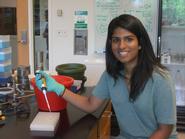
In the brain of every insect embryo, budding neurons grow and develop, in the same way as in the human brain. The developing nervous system is fragile, and as the neurons become more developed, the organism’s body becomes a coordinated machine capable of both voluntary and involuntary actions whose messages pass through these essential pathways. The protein tyramene beta hydroxelase (TBh) has been found in the budding neurons in insect embryos, as well as its relative TBhR (R is for “related”).
The blueprints for making TBhR have been found in the endoplasmic reticulum, the organelle responsible for making proteins, in every type of insect, but a lot remains to be seen about the perpetuation and function of this protein. Sumithra Nair ’12, working with Professor of Biology Herman Lehman, will try to shed some light on this common, essential yet enigmatic protein.
But before Nair and Professor Lehman can begin to answer their questions such as the protein’s natural substrate, or what it needs to be present, and what is needed to express the protein, they have to see it in action. It is Nair’s job to express the protein so that they will be able to test it. To do this, she first grows bacteria in which she inserted the sequence for TBhR into the plasmid, the bacteria’s DNA that forms a circular shape. She runs a polymerase chain reaction (PCR) on this segment to ensure that the DNA is in the right place. She then “cuts” that segment of DNA out of the plasmid using enzymes and inserts it into other bacteria. This second type of bacteria then prepares the DNA to be inserted into a final type, called “competent cells,” which means that they will finally secrete the desired protein. If all steps are successful, Nair will have generated the TBhR, which can then be tested and better understood.
However, all of these steps are hardly foolproof. Currently, Nair is struggling with enzymes that do not cut the DNA in the correct location, an error that she cannot know until she puts the DNA through gel electrophoresis. She won’t know if she was successful in expressing TBhR until the final step, which will hopefully be completed at the end of the summer.
Despite how little is known about this particular protein, Professor Lehman has a hypothesis based on what scientists do already know about the related protein TBh. TBhR, he believes, may act as the signal for the endoplasmic reticulum to arrest the cell cycle when it sees a misfolded protein. Practically, that means that protein blueprints that have been imperfectly transposed will not be used, preventing damage to the organism—a function that is especially important in growing neurons, where TBhR has been found. Nair’s work is the first step, bringing the scientific community closer to understanding the function and properties of TBhR.
Nair is a pre-med biology major. She is a member of the Mock Trial Team and of Students for International Public Health Awareness (SFIPHA). She enjoys playing volleyball in her spare time and is an EMT in her hometown of Cresskill, N.J.
Sumithra Nair is a graduate of Cresskill High School (N.J.)
The blueprints for making TBhR have been found in the endoplasmic reticulum, the organelle responsible for making proteins, in every type of insect, but a lot remains to be seen about the perpetuation and function of this protein. Sumithra Nair ’12, working with Professor of Biology Herman Lehman, will try to shed some light on this common, essential yet enigmatic protein.
But before Nair and Professor Lehman can begin to answer their questions such as the protein’s natural substrate, or what it needs to be present, and what is needed to express the protein, they have to see it in action. It is Nair’s job to express the protein so that they will be able to test it. To do this, she first grows bacteria in which she inserted the sequence for TBhR into the plasmid, the bacteria’s DNA that forms a circular shape. She runs a polymerase chain reaction (PCR) on this segment to ensure that the DNA is in the right place. She then “cuts” that segment of DNA out of the plasmid using enzymes and inserts it into other bacteria. This second type of bacteria then prepares the DNA to be inserted into a final type, called “competent cells,” which means that they will finally secrete the desired protein. If all steps are successful, Nair will have generated the TBhR, which can then be tested and better understood.
However, all of these steps are hardly foolproof. Currently, Nair is struggling with enzymes that do not cut the DNA in the correct location, an error that she cannot know until she puts the DNA through gel electrophoresis. She won’t know if she was successful in expressing TBhR until the final step, which will hopefully be completed at the end of the summer.
Despite how little is known about this particular protein, Professor Lehman has a hypothesis based on what scientists do already know about the related protein TBh. TBhR, he believes, may act as the signal for the endoplasmic reticulum to arrest the cell cycle when it sees a misfolded protein. Practically, that means that protein blueprints that have been imperfectly transposed will not be used, preventing damage to the organism—a function that is especially important in growing neurons, where TBhR has been found. Nair’s work is the first step, bringing the scientific community closer to understanding the function and properties of TBhR.
Nair is a pre-med biology major. She is a member of the Mock Trial Team and of Students for International Public Health Awareness (SFIPHA). She enjoys playing volleyball in her spare time and is an EMT in her hometown of Cresskill, N.J.
Sumithra Nair is a graduate of Cresskill High School (N.J.)
Posted July 11, 2010
